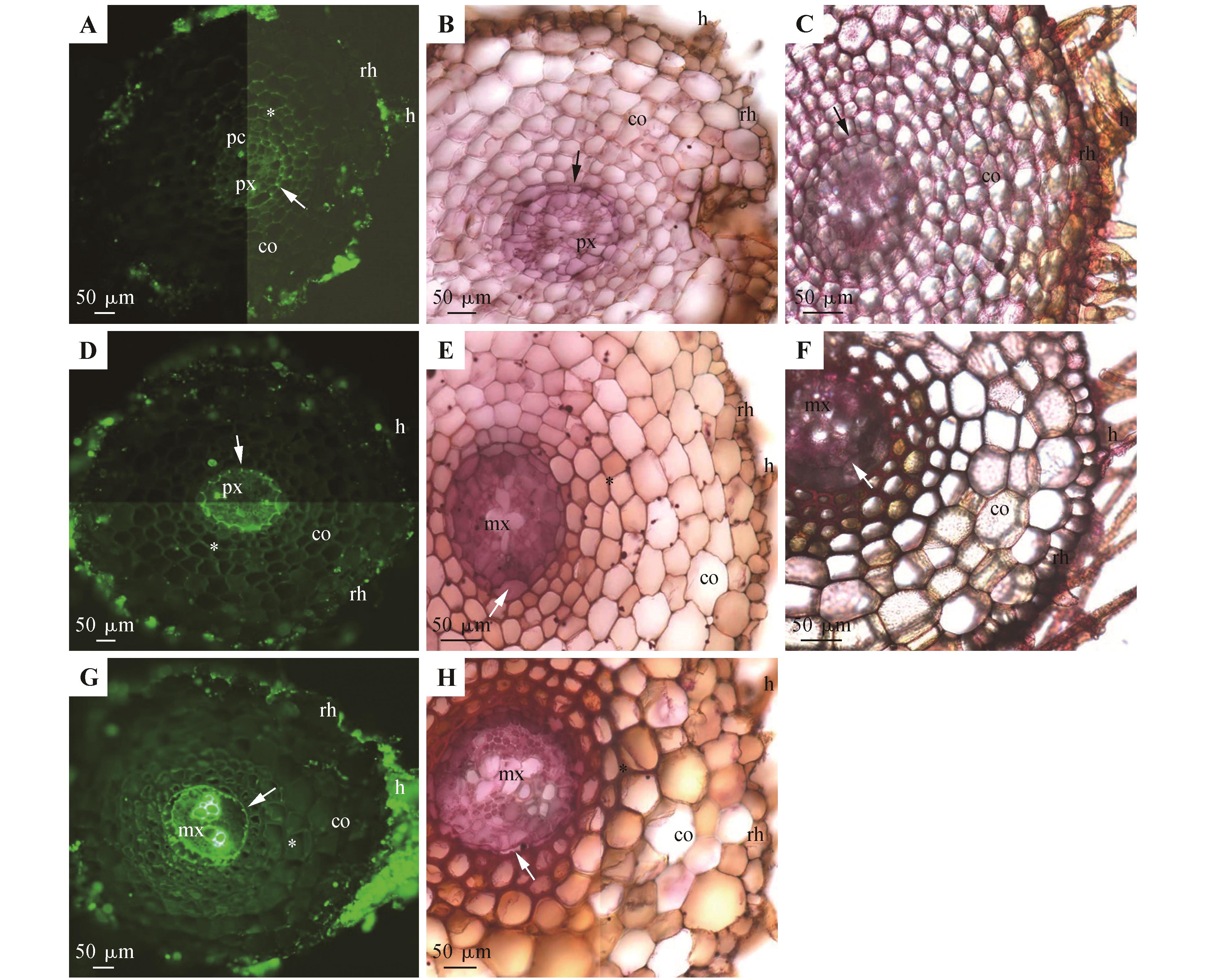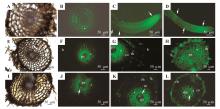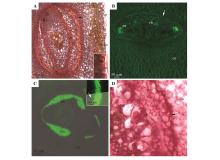Bulletin of Botanical Research ›› 2023, Vol. 43 ›› Issue (1): 20-29.doi: 10.7525/j.issn.1673-5102.2023.01.003
• Systematic and Evolutionary • Previous Articles Next Articles
Teng LI1, Cunyu ZHOU1( ), Chaodong YANG1, Zhanfeng LIU2
), Chaodong YANG1, Zhanfeng LIU2
Received:2021-12-18
Online:2023-01-20
Published:2022-12-23
Contact:
Cunyu ZHOU
E-mail:zhoucy@yangtzeu.edu.cn
About author:LI Teng(1995—),male,master postgraduates,mainly engaged in the study of wetland plants and ecological restoration.
Supported by:CLC Number:
Teng LI, Cunyu ZHOU, Chaodong YANG, Zhanfeng LIU. Anatomical and Histochemical Features of the Pteris vittata (Pteridaceae)[J]. Bulletin of Botanical Research, 2023, 43(1): 20-29.
Add to citation manager EndNote|Ris|BibTeX
URL: https://bbr.nefu.edu.cn/EN/10.7525/j.issn.1673-5102.2023.01.003

Fig.1
Photomicrographs of crosscutting of the adventitious roots of P. vittata(Length 20~56 mm)A-C.Sectioned at 10 mm from the root tip;D-F.Sectioned at 20 mm from the root tip;G-H.Sectioned at 30 mm from the root tip;A,D,G.Stained with berberine hemisulfate-aniline blue,under ultraviolet light;B,E,H.Stained with Sudan Red 7B,under brightfield;C,F.Stained with ruthenium red, under brightfield;A.Protoxylem, endodermis(arrow),passage cells,lignified cortex(*),cortex,rhizodermis,hairs;B.Protoxylem,endodermis(arrow),cortex,rhizodermis,hairs;C.Endodermis(arrow),cortex,rhizodermis,hairs;D.Protoxylem,endodermis(arrow),lignified cortex(*),cortex,rhizodermis,hairs;E.Metaxylem,endodermis(arrow),lignified thickened cortex(*),cortex,rhizodermis,hairs;F.Metaxylem,endodermis(arrow),cortex,rhizodermis,hairs;G.Metaxylem,endodermis(arrow),lignified cortex(*),cortex,rhizodermis,hairs;H.Metaxylem,endodermis(arrow),lignified thickened cortex(*),cortex,rhizodermis,hairs;co.Cortex;cu.Cuticles;h.Hairs;hy.Hypodermis;mx.Metaxylem;pa.Palisade tissue;pc.Passage cells;px.Protoxylem;rh.Rhizodermis;sp.Spongy tissue;vb.Vascular bundles;ve.Vein


Fig.2
The permeability of the apoplastic barriers in the roots of P. vittata(Length 20~50 mm)A-B.Sectioned at 5 mm from the root tip;C-D.Intact root apex;E-H.Sectioned at 10 mm from the root tip;I-L.Sectioned at 20 mm from the root tip;A,E,I.Unstained,under brightfield;B,F,J.Unstained,autofluorescence under ultraviolet light;C,G,K.Treated with berberine tracer under ultraviolet light;D,H,L.Treated with berberine and KSCN solution under ultraviolet light;A.Cortex,rhizodermis,hairs;B.Lignified thickened cortex (*);C.Root tip showing strong yellow fluorescence(arrow);rhizodermis surface and hairs stained with berberine(arrow).;D.Root tip showing strong yellow fluorescence(arrow),rhizodermis surface and hairs stained with berberine thiocyanate(arrow);E.Lignified thickened cortex (*),cortex,rhizodermis,hairs;F.Protoxylem,lignified thickened cortex(*),hairs;G.Protoxylem,lignified cortex(*),cortex;rhizodermis and hairs stained with berberine;H.Protoxylem,lignified thickened cortex(*),hypodermis;rhizodermis and hairs stained with berberine thiocyanate;I.Lignified thickened cortex(*),cortex,rhizodermis,hairs;J.Protoxylem,endodermis(arrow),lignified thickened cortex(*);K.Protoxylem,endodermis(arrow),lignified cortex(*),cortex;rhizodermis and hairs stained with berberine;L.Metaxylem,endodermis(arrow),lignified cortex (*),cortex;rhizodermis and hairs stained with berberine thiocyanate


Fig.3
Photomicrographs of crosscutting of the rhizomes of P. vittata(Length 19~42 mm)A.Vascular bundles,endodermis(arrow),cortex,epidermis,cuticle;Stained with Sudan Red 7B under brightfield;Insets shows the cuticle on the epidermal surface,stained with sudan red 7B;B.Vascular bundles,protoxylem,endodermis(arrow),cortex;Stained with berberine sulfate-aniline blue;C.Vascular bundles,metaxylem;Insets shows the endodermis(arrow);Stained with berberine sulfate-aniline blue;D.Vascular bundles,endodermis(arrow),cortex;Stained with sudan red 7B


Fig.4
Photomicrographs of the mature stipes and leaves of P. vittataAll panels showed berberine hemisulfate-aniline blue staining under UV light,except where noted;A.Stipe section. Vascular bundles,cortex,peripheral sclerenchyma layer (*);Upper inset shows the suberized endodermis(arrow);Lower inset shows the cuticle on the epidermal surface. Insets stained with Sudan Red 7B under brightfield;B.Magnification of panel A;Vascular bundles,endodermis(arrow),cortex,peripheral sclerenchyma layer(*);C.Section of the pinna vein;Vascular bundles,endodermis(arrow),cortex,peripheral sclerenchyma layer(*),cuticle;D.Section of the pinna vein;Vascular bundles,endodermis(arrow),cortex,peripheral sclerenchyma layer(*),cuticle;Stained with Sudan Red 7B under brightfield;E.Leaf blade section,adaxial side up;Palisade tissue,spongy tissue,cuticle;F.Leaf blade section,adaxial side up;Fine vein endodermis(arrow);G. Leaf blade section,adaxial side up;Palisade tissue,spongy tissue,fine vein,endodermis(arrow),cuticle;Stained with Sudan Red 7B,under brightfield;H.Abaxial surface of leaf blade;Stoma(arrow);Unstained,under brightfield;I.Adaxial surface of leaf blade;Epidermis(*)

| 1 | 张泽宏,吴小霞.5种蕨类植物叶片解剖结构及其对阴生环境的适应性研究[J].华中师范大学学报(自然科学版),2013,47(6):840-843. |
| ZHANG Z H, WU X X.Study on the anatomy structure of five species of fern leaves and its adaptability to sciophyte environment[J].Journal of Huazhong Normal University(Natural Sciences),2013,47(6):840-843. | |
| 2 | LOMBI E, ZHAO F J, FUHRMANN M,et al.Arsenic distribution and speciation in the fronds of the hyperaccumulator Pteris vittata [J].New Phytologist,2002,156(2):195-203. |
| 3 | CAILLE N, ZHAO F J, MCGRATH S P.Comparison of root absorption,translocation and tolerance of arsenic in the hyperaccumulator Pteris vittata and the nonhyperaccumulator Pteris tremula [J].New Phytologist,2005,165(3):755-761. |
| 4 | SU Y H, MCGRATH S P, ZHU Y G,et al.Highly efficient xylem transport of arsenite in the arsenic hyperaccumulator Pteris vittata [J].New Phytologist,2008,180(2):434-441. |
| 5 | WAGNER S, HOEFER C, PUSCHENREITER M,et al.Arsenic redox transformations and cycling in the rhizosphere of Pteris vittata and Pteris quadriaurita [J].Environmental and Experimental Botany,2020,177:104122. |
| 6 | ZHAO F J, DUNHAM S J, MCGRATH S P.Arsenic hyperaccumulation by different fern species[J].New Phytologist,2002,156(1):27-31. |
| 7 | DE OLIVEIRA L M, GRESS J, DE J,et al.Sulfate and chromate increased each other’s uptake and translocation in As-hyperaccumulator Pteris vittata [J].Chemosphere,2016,147:36-43. |
| 8 | SOURI Z, KARIMI N, SANDALIO L M.Arsenic hyperaccumulation strategies:an overview[J].Frontiers in Cell and Developmental Biology,2017,5:67. |
| 9 | WYLIE R B.Variations in leaf structure among ‘Adiantum pedatum plants growing in a rock cavern[J].American Journal of Botany,1949,36(3):282-287. |
| 10 | SRIDHAR B B M, HAN F X, DIEHL S V,et al.Effect of phytoaccumulation of arsenic and chromium on structural and ultrastructural changes of brake fern(Pteris vittata) [J].Brazilian Journal of Plant Physiology,2011,23(4):285-293. |
| 11 | MARTÍNEZ O G, VILTE I.The structure of petioles in Pteris(Pteridaceae)[J].American Fern Journal,2012,102(1):1-10. |
| 12 | ZHANG G M, LIAO W B, DING M Y,et al.Flora of China:Vol.2/3:Pteridaceae[M].Beijing:Science Press,2013:169-256. |
| 13 | NEIRA D A, ANDRADA A R, DE LOS ÁNGELES PÁEZ V,et al.Anatomical,histochemical and cytogenetic features of Doryopteris triphylla(Pteridaceae)[J].American Journal of Plant Sciences,2017,8(4):907-920. |
| 14 | SÂRBU A, SMARANDACHE D, MARINESCU A T,et al.Anatomical-histological observations conducted on aquatic ferns in the Danube Delta[J].Journal of Plant Development,2017,24:3-21. |
| 15 | WETZEL M L R, SYLVESTRE LDA S, BARROS C F,et al.Vegetative anatomy of Aspleniaceae Newman from Brazilian Atlantic rainforest and its application in taxonomy[J].Flora,2017,233:118-126. |
| 16 | GAAFAR A A, ALI S I, FARIED A M,et al.An insight into chemical content,biological effect and morphological features of Pteris vittata L.,rarely growing in Egypt[J].Research Journal of Chemistry and Environment,2018,22(10):47-55. |
| 17 | WU D, LI L B, MA X B,et al.Morphological and anatomical adaptations to dry,shady environments in Adiantum reniforme var.sinense(Pteridaceae)[J].PeerJ,2020,8:e9937. |
| 18 | KATO M, IMAICHI R.Morphological diversity and evolution of vegetative organs in pteridophytes[J].Evolution and Diversification of Land Plants,1997,27-43. |
| 19 | LI X, FANG Y H, YANG J,et al.Overview of the morphology,anatomy,and ontogeny of Adiantum capillus-veneris:an experimental system to study the development of ferns[J].Journal of Systematics and Evolution,2013,51(5):499-510. |
| 20 | VASCO A, MORAN R C, AMBROSE B A.The evolution,morphology,and development of fern leaves[J].Frontiers in Plant Science,2013,4:345. |
| 21 | PLACKETT A R G, DI STILIO V S, LANGDALE J A.Ferns:the missing link in shoot evolution and development[J].Frontiers in Plant Science,2015,6:972. |
| 22 | HARRISON C J, MORRIS J L.The origin and early evolution of vascular plant shoots and leaves[J].Philosophical Transactions of the Royal Society B-Biological Sciences,2018,373(1739):20160496. |
| 23 | HUIET L, LI F W, KAO T T,et al.A worldwide phylogeny of Adiantum(Pteridaceae) reveals remarkable convergent evolution in leaf blade architecture[J].TAXON,2018,67(3):488-502. |
| 24 | CHAPPLE C C S, PETERSON R L.Root structure in the fern Platycerium bifurcatum(Cav.) C.Chr.(Polypodiaceae)[J].Botanical Gazette,1987,148(2):180-187. |
| 25 | DAMUS M, PETERSON R L, ENSTONE D E,et al.Modifications of cortical cell walls in roots of seedless vascular plants[J].Botanica Acta,1997,110(2):190-195. |
| 26 | SCHNEIDER H.Root anatomy of Aspleniaceae and the implications for systematics of this fern family[J].Fern Gazette,1997,15:160-168. |
| 27 | HOSE E, CLARKSON D T, STEUDLE E,et al.The exodermis:a variable apoplastic barrier[J].Journal of Experimental Botany,2001,52(365):2245-2264. |
| 28 | ALBERSHEIM P, DARVILL A, ROBERTS K,et al.Plant cell walls:from chemistry to biology[M].New York:Garland Science,2011. |
| 29 | JOCA T A C, DE OLIVEIRA D C, ZOTZ G,et al.The velamen of epiphytic orchids:variation in structure and correlations with nutrient absorption[J].Flora,2017,230:66-74. |
| 30 | JOCA T A C, DE OLIVEIRA D C, ZOTZ G,et al.Chemical composition of cell walls in velamentous roots of epiphytic Orchidaceae[J].Protoplasma,2020,257(1):103-118. |
| 31 | RIBEIRO M L R C, SANTOS M G, MORAES M G.Leaf anatomy of two Anemia Sw.species(Schizaeaceae-Pteridophyte) from a rocky outcrop in Niterói,Rio de Janeiro,Brazil[J].Revista Brasileira de Botânica,2007,30(4):695-702. |
| 32 | DE LOS ÁNGELES LAGORIA M, AVILA G, NEIRA D A,et al.Morphoanatomical and histochemical characteristics of the epiphytic fern Pleopeltis macrocarpa(Polypodiaceae)[J].Brazilian Journal of Botany,2018,41(3):739-750. |
| 33 | MAHLEY J N, PITTERMANN J, NICK R,et al.Geometry,allometry and biomechanics of fern leaf petioles:their significance for the evolution of functional and ecological diversity within the Pteridaceae[J].Frontiers in Plant Science,2018,9:197. |
| 34 | PALACIOS-RÍOS M, GALÁN J M G Y, PRADA C,et al.Structure of the petioles and costae of Mexican and central American species of Pteris (Polypodiopsida,Pteridaceae) [J].Phytotaxa,2019,401(2):101-116. |
| 35 | HOLTTUM R E, OGURA Y.Comparative anatomy of vegetative organs of the pteridophytes[J].Kew Bulletin,1973,28(3):538. |
| 36 | LERSTEN N R.Occurrence of endodermis with a casparian strip in stem and leaf[J].The Botanical Review,1997,63(3):265-272. |
| 37 | ENSTONE D E, PETERSON C A, MA F S.Root endodermis and exodermis:structure,function,and responses to the environment[J].Journal of Plant Growth Regulation,2002,21(4):335-351. |
| 38 | HERNÁNDEZ-HERNÁNDEZ V, TERRAZAS T, MEHLTRETER K,et al.Studies of petiolar anatomy in ferns:structural diversity and systematic significance of the circumendodermal band[J].Botanical Journal of the Linnean Society,2012,169(4):596-610. |
| 39 | GELDNER N.The endodermis[J].Annual Review of Plant Biology,2013,64:531-558. |
| 40 | XIANG J Q, MING J J, YIN H Q,et al.Anatomy and histochemistry of the roots and shoots in the aquatic selenium hyperaccumulator Cardamine hupingshanensis(Brassicaceae)[J].Open Life Sciences,2019,14:318-326. |
| 41 | YANG C D, ZHANG X, ZHOU C Y,et al.Root and stem anatomy and histochemistry of four grasses from the Jianghan Floodplain along the Yangtze River,China[J].Flora,2011,206(7):653-661. |
| 42 | YANG C D, ZHANG X, LI J K,et al.Anatomy and histochemistry of roots and shoots in wild rice(Zizania latifolia Griseb.) [J].Journal of Botany,2014:181727. |
| 43 | YANG C D, YANG X L, ZHANG X,et al.Anatomical structures of alligator weed (Alternanthera philoxeroides) suggest it is well adapted to the aquatic-terrestrial transition zone[J].Flora,2019,253:27-34. |
| 44 | YANG C D, ZHANG X, WANG T,et al.Phenotypic plasticity in the structure of fine adventitious Metasequoia glyptostroboides roots allows adaptation to aquatic and terrestrial environments[J].Plants-Basel,2019,8(11):501. |
| 45 | YANG C D, ZHANG X, ZHANG F,et al.Structure and ion physiology of Brasenia schreberi glandular trichomes in vivo[J].PeerJ,2019,7:e7288. |
| 46 | YANG C D, ZHANG X, SEAGO J L,Jr.,et al.Anatomical and histochemical features of Brasenia schreberi(Cabombaceae) shoots[J].Flora,2020,263:151524. |
| 47 | ZHANG X, HU L J, YANG C D,et al.Structural features of Phalaris arundinacea in the Jianghan Floodplain of the Yangtze River,China[J].Flora,2017,229:100-106. |
| 48 | ZHANG X, YANG C D, SEAGO J L,Jr..Anatomical and histochemical traits of roots and stems of Artemisia lavandulaefolia and A.selengensis(Asteraceae) in the Jianghan Floodplain,China[J].Flora,2018,239:87-97. |
| 49 | SEAGO J L Jr.Revisiting the occurrence and evidence of endodermis in angiosperm shoots[J].Flora,2020,273:151709. |
| 50 | PECKOVÁ E, TYLOVÁ E, SOUKUP A.Tracing root permeability:comparison of tracer methods[J].Biologia Plantarum,2016,60(4):695-705. |
| 51 | LÓPEZ-PÉREZ L, FERNÁNDEZ-GARCÍA N, OLMOS E,et al.The phi thickening in roots of broccoli plants:an acclimation mechanism to salinity?[J].International Journal of Plant Sciences,2007,168(8):1141-1149. |
| 52 | FERNANDEZ-GARCIA N, LOPEZ-PEREZ L, HERNANDEZ M,et al.Role of phi cells and the endodermis under salt stress in Brassica oleracea [J].New Phytologist,2009,181(2):347-360. |
| 53 | ALEAMOTUA M, MCCURDY D W, COLLINGS D A.Phi thickenings in roots:novel secondary wall structures responsive to biotic and abiotic stresses[J].Journal of Experimental Botany,2019,70(18):4631-4642. |
| 54 | KOVÁČ J,LUX A, SOUKUP M,et al.A new insight on structural and some functional aspects of peri-endodermal thickenings,a specific layer in Noccaea caerulescens roots[J].Annals of Botany,2020,126(3):423-434. |
| 55 | RUZIN S E.Plant microtechnique and microscopy[M].New York:Oxford University Press,1999. |
| 56 | BRUNDRETT M C, KENDRICK B, PETERSON C A.Efficient lipid staining in plant material with Sudan red 7B or fluoral yellow 088 in polyethylene glycol-glycerol[J].Biotechnic & Histochemistry,1991,66(3):111-116. |
| 57 | BRUNDRETT M C, ENSTONE D E, PETERSON C A.A berberine-aniline blue fluorescent staining procedure for suberin,lignin,and callose in plant tissue[J].Protoplasma,1988,146:133-142. |
| 58 | SEAGO J L Jr, PETERSON C A, ENSTONE D E,et al.Development of the endodermis and hypodermis of Typha glauca Godr. and Typha angustifolia L.roots[J].Canadian Journal of Botany,1999,77(1):122-134. |
| 59 | PETERSON R L, PETERSON C A, MELVILLE L H.Teaching plant anatomy through creative laboratory exercises[M].Ottawa:NRC Press,2008:164. |
| 60 | MEYER C J, SEAGO J L,Jr., PETERSON C A.Environmental effects on the maturation of the endodermis and multiseriate exodermis of Iris germanica roots[J].Annals of Botany,2009,103(5):687-702. |
| 61 | MEYER C J, PETERSON C A.Casparian bands occur in the periderm of Pelargonium hortorum stem and root[J].Annals of Botany,2011,107(4):591-598. |
| 62 | FAHN A.Plant Anatomy[M].4th ed.Oxford:Pergamon Press,1990. |
| 63 | EVERT R F.Esau’s plant anatomy:meristems,cells,and tissues of the plant body:their structure,function,and development[M].3rd ed.Hoboken:Wiley-Interscience,2006. |
| 64 | CRANG R, LYONS-SOBASKI S, WISE R.Microscopy and imaging:a concept-based approach to the structure of seed plants[M].Plant Anatomy,2018. |
| 65 | LUNA M L, GANEM M A, GROSSI M A,et al.Root anatomy of 37 species of Asplenium(Aspleniaceae) from Argentina:contributions to the systematics and phylogeny of the genus[J].Flora,2020,272:151706. |
| 66 | BONDADA B, TU C, MA L.Surface structure and anatomical aspects of Chinese brake fern(Pteris vittata; Pteridaceae) [J].Brittonia,2006,58:217-228. |
| 67 | LEROUX O, BAGNIEWSKA-ZADWORNA A, RAMBE S K,et al.Non-lignified helical cell wall thickenings in root cortical cells of Aspleniaceae(Polypodiales):histology and taxonomical significance[J].Annals of Botany,2011,107(2):195-207. |
| 68 | HERNÁNDEZ M A, TERÁN L, MATA M,et al.Helical cell wall thickenings in root cortical cells of Polypodiaceae species from Northwestern Argentina[J].American Fern Journal,2013,103(4):225-240. |
| 69 | FENG S M, NING K, LUAN D,et al.Chemical composition and antioxidant capacities analysis of different parts of Brasenia schreberi [J].Journal of Food Processing and Preservation,2019,43(8):e14014. |
| 70 | TAO Q, LIU Y K, LI M,et al.Cd-induced difference in root characteristics along root apex contributes to variation in Cd uptake and accumulation between two contrasting ecotypes of Sedum alfredii [J].Chemosphere,2020,243:125290. |
| 71 | WARDLAW C W.Experimental and analytical studies of Pteridophytes:IV.Stelar morphology:experimental observations on the relation between leaf development and stelar morphology in species of Dryopteris and Onoclea [J].Annals of Botany,1944,8(4):387-388. |
| 72 | SRIVASTAVA A, CHANDRA S.Structure and organization of the rhizome vascular system of four Polypodium species[J].American Fern Journal,2009,99(3):182-193. |
| 73 | DEROIN T, RAKOTONDRAINIBE F.Comparative rhizome anatomy of some species of Ceradenia L.E.Bishop and Zygophlebia L.E.Bishop(Polypodiaceae,formerly Grammitidaceae) from Madagascar[J].Modern Phytomorphology,2015,7:5-12. |
| 74 | BECARI-VIANA I, SCHWARTSBURD P B.Morpho-anatomical studies and evolutionary interpretations of the rhizomes of extant Dennstaedtiaceae[J].American Fern Journal,2017,107(3):105-123. |
| 75 | NORAINI T,DAMANHURI.Taxonomic value of the stipe anatomy in Davallia(Davalliaceae) in Peninsular Malaysia[J].Malayan Nature Journal,2014,65(65):130-144. |
| 76 | NORAINI T, AMIRUL-AIMAN A J, JAMAN R,et al.Systematic significance of stipe anatomy in peninsular Malaysian Blechnum L.(Blechnaceae) species[J].Malaysian Applied Biology,2014,43(2):119-128. |
| 77 | 袁王俊,张维瑞,尚富德.黄连营养器官解剖结构与其阴生环境相关性研究[J].河南大学学报(自然科学版),2007,37(2):184-186. |
| YUAN W J, ZHANG W R, SHANG F D.Study on the anatomical structure of vegetative organs of Coptis chinensis and its pertinence to sciophyte conditions[J].Journal of Henan University(Natural Science),2007,37(2):184-186. | |
| 78 | DEMATTEIS B, SOLIS S M, YESILYURT J C,et al.Comparative anatomy in four Cheilanthoid ferns[J].Boletin de la Sociedad Argentina de Botanica,2019,54(2):203-214. |
| 79 | SHAH S N, AHMAD M, ZAFAR M,et al.Leaf micromorphological adaptations of resurrection ferns in Northern Pakistan[J].Flora,2019,255:1-10. |
| 80 | OLADIPO O T, PHILIP T V, BAMIGBOYE R A,et al.Morphology and anatomy of three species of Asplenium L.at Obafemi Awolowo University Ile-Ife,Nigeria[J].Ife Journal of Science,2020,22(1):65-73. |
| [1] | Li LI, Xin WANG, Yuejing ZHANG, Lingyun JIA, Hailong PANG, Hanqing FENG. Effects of Abiotic Stresses on the Intracellular and Extracellular ATP Levels of Tobacco Suspension Cells [J]. Bulletin of Botanical Research, 2023, 43(2): 179-185. |
| [2] | MENG Qing-Huan1;ZU Yuan-Gang1;WANG Hua2;WANG Hong-Zheng1;JIANG Tao3;WU Wei-Wei1;ZHONG Chen1;DUAN Xi-Hua1*. Enzyme Assisted Ethanol Extraction of Total Flavonoids from Peony Episperm [J]. Bulletin of Botanical Research, 2015, 35(4): 628-631. |
| [3] | YANG Chao-Dong;ZHANG Xia. Permeability and Supplement Structures of Stems of Paspalum distichum [J]. Bulletin of Botanical Research, 2013, 33(5): 564-568. |
| [4] | YANG Chao-Dong;ZHANG Xia;LIU Guo-Feng;ZHANG Jun-Wei;BAO Man-Zhu;ZHOU Zhi-Xiang. Progress on the Structure and Physiological Functions of Apoplastic Barriers in Root [J]. Bulletin of Botanical Research, 2013, 33(1): 114-119. |
| [5] | LIU Ya-Li;WANG Qing-Cheng*;LIU Shuang;YANG Yuan-Biao;PENG Hong-Mei;HAO Long-Fei. Effects of Water Stress on Plasma membrane Permeability and Protective Enzyme Activities of Red Pine Seedlings Needles [J]. Bulletin of Botanical Research, 2011, 31(1): 49-55. |
| [6] | XU Yu-Feng;WANG Lei;WANG Wen-Yuan;SONG Zhe;WANG Dan. Research on Physiological Characteristics of Salt Resistance in Iris lactea var.chinensis [J]. Bulletin of Botanical Research, 2009, 29(5): 549-552. |
| [7] | BAO Fang;SHI Fu-Chen*. Comparative Study on Physiological Characteristics Between an Invasive Plant Spartina alterniflora and Indigenous Plant Phragmites communis [J]. Bulletin of Botanical Research, 2007, 27(4): 421-427. |
| [8] | Wan Qing-lin, Liu Ming-yuan. A PRELIMINARY STUDY ON COLD RESISTANT PHYSIOLOGY OF RUTA GRAVEOLENS [J]. Bulletin of Botanical Research, 1997, 17(2): 190-194. |
| Viewed | ||||||
|
Full text |
|
|||||
|
Abstract |
|
|||||